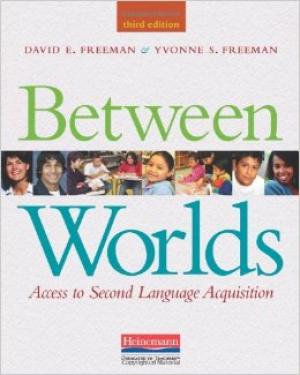Language Acquisition & Instruction

These books provide helpful overviews of the different theories of language acquisition, as well as information about language instruction for all ages.
Jump to navigation Jump to Content

These books provide helpful overviews of the different theories of language acquisition, as well as information about language instruction for all ages.
In the third edition of this title by ELL experts David E. and Yvonne S. Freeman, the authors present the most up-to-date research from the field regarding second language acquisition and best practices for ELLs in a format that is accessible and easy to use. Topics include in-depth case studies of students, as well as theories of language acquisition, bilingual education, reading instruction, academic language, and how a school's cultural orientation impacts student language learning. Each chapter also presents discussion questions, classroom examples, and teacher reflections.
This valuable handbook provides ELL educators, speech-language pathologists, special educators, and teacher trainers with an in-depth, research-based introduction to the language development and disorders of dual-language learners (both students who are fully bilingual and those who are learning a second language). Topics include the impact of culture on language; language development for internationally adopted students; assessment strategies for identifying language and reading disorders; and intervention approaches for dual-language learners with language/reading impairments.
Product Description: When teachers are familiar with basic linguistic concepts, they are better prepared to make decisions about how to teach reading, spelling, phonics, and grammar to all students, including English language learners. In this unique linguistics course-in-a-book, David and Yvonne Freeman explain essential linguistic concepts in a thorough, but manageable manner and show the connections between linguistic theory and classroom practice.
Dr. Wayne E. Wright offers a timely overview of the ELL field for educators and administrators that includes chapters about: ELL demographics; second-language theory; historical background; ELL policy at the federal, state, and local level; ELL assessment; language instruction; content-area instruction; primary language support; and technology in the classroom. Chapters tools such as guiding questions, activities, key terms, supporting documents, and exercises available on a companion website make this an essential resource for pre-service courses and professional development.
Dr. Nancy Akhavan of California State University, Fresno, walks teachers through "language workshop," an approach that focuses on the specific language needs of every child, allowing teachers the flexibility to scaffold instruction by modeling specific uses of language, posing problems and ideas that expand kids' language skills, and teaching specific thinking strategies. Dr. Akhavan provides teachers with the tools to help students will find the guidance and opportunity necessary for acquiring language, learn the structures of discussion and debate, and think through ideas and texts.
Product Description: This accessible resource familiarizes early childhood professionals with linguistics, the scientific study of language. Knowledge of linguistics will enable early childhood educators to successfully teach young children core competencies, ranging from phonemic awareness, reading and math, to health literacy and intercultural awareness. The text includes numerous real-life examples for diverse age groups and learning styles. The online Resource Guide provides hands-on activities and contributions by top scholars in the field.
In this groundbreaking guide, Debbie Zacarian, EdD, provides a new perspective on the role of academic language in the engagement and success of all students, including English language learners. Using numerous classroom examples, she outlines strategies for connecting academic language to students' lives, building upon students' previous literacy experiences, and engaging parents around activities that foster academic language development. Zacarian also includes reflection questions and guiding graphic organizers and rubrics.
Product Description: Reflecting 10 years of dramatic change in early education — especially in critical areas like assessment and cultural diversity — this fully revised edition gives teachers up-to-date research, usable information, and essential tools to meet the needs of second language learners in today's learning environments.
This guide offers a broad overview and introduction to ELL instruction. Resources include graphic organizers, classroom strategies, and research summaries, as well as some California-specific material.
Teachers in dual-language settings need a resource that gives them research-based instructional advice for helping all students meet standards while giving nonnative speakers access to the same high-quality education as their English-speaking peers.
Product Description: In this ambitious book, Rosemary Salomone uses the heated debate over how best to educate immigrant children as a way to explore what national identity means in an age of globalization, trans-nationalism, and dual citizenship. She reveals the little-known legislative history of bilingual education, its dizzying range of meanings in different schools, districts, and states, and the difficulty in proving or disproving whether it works — or defining it as a legal right.
Based on their experience and success in using the Language Experience Approach (LEA) with English language learners, authors Nessel and Dixon provide K-12 educators with a helpful guide on how to implement LEA in their own classrooms. The authors begin with an overview of the approach and why they believe it is so effective with ELLs. They then offer strategies to use with students of varying proficiency and confidence levels, as well as targeted strategies for using LEA in both reading and writing instruction.
Product Description: Professor Danling Fu draws on her classroom experience with ELLs to share an approach to writing instruction that puts the literacy knowledge students bring from their native language and putting writing at the center of the curriculum. She describes the helpful role native literacy plays in building written English fluency as writers use code-switching and movement between languages to scaffold transitional writing, even in cases where teachers do not know a student's home language.
See more great related resources and videos in our Multicultural Literature section!
